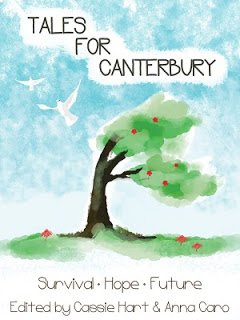Book Review: Tales for Canterbury: Survival – Hope – Future
A Post For NZ Speculative Fiction Blogging Week.
(Disclaimer: Tales for Canterbury includes my story “Sign of the Tui”, which I have not attempted to review!)
Tales for Canterbury, as people who follow this blog may know, is an anthology of short stories (and a poem) which was pulled together very quickly by its editors, Cassie Hart and Anna Caro, in the wake of the 22 February earthquake which caused many deaths and much destruction in Christchurch. All the work appearing in the anthology, and the very considerable time and effort invested by the editors, was donated, and all proceeds from the book are being donated to the New Zealand Red Cross Christchurch Earthquake Appeal.
Well. I’ve gone on the record before saying what a good cause this is, and how richly it deserves your support. I’ve mentioned what a remarkable line-up of authors Anna and Cassie pulled together at very short notice – a mixture of international big names and New Zealand authors ranging . But what of the stories (and the poem) themselves? Do I recommend the anthology purely for the quality of the work included. Should you buy it for entirely selfish motives?
The answer is, most emphatically, yes. Tales for Canterbury is full of good stories, and what especially impressed me is that just as many of my favourite stories in the collection come from the lesser-known authors as come from the big names.
But (I hear you asking – but then, my hearing is not what it was) why is this a post for NZ Spec Fic Blogging Week? Well, this collection consists of about 2/3 speculative fiction (SF, fantasy and horror) stories to 1/3 literary fiction stories of various stripes, and quite a lot of that spec fic is written by New Zealand authors.
So. Here are a baker’s-dozen-minus-one* of the pieces that particularly moved, excited or impressed me in Tales for Canterbury. (I should say that I liked nearly all of the other stories, too!)
*Known in our Earth language as “a dozen”.
- The opening story, “Broadwing” by Simon Petrie, is an SF story set on Titan that could easily be an extract from a Kim Stanley Robinson novel about the colonisation of the outer solar system. Coming from me, that’s high praise indeed.
- Neil Gaiman’s contribution is a poem, “Inventing Aladdin”. I was, at first, slightly disappointed when I saw that Neil Gaiman had contributed a poem rather than a story. I needn’t have been. “Inventing Aladdin” is a fine poem, with a killer last line.
- I have never quite decided what my favourite story is in Tales for Canterbury, but “My Dad, The Tuatara” by Amanda Fitzwater is right up there. This is a lovely piece of magic realism, happily at home right on the border of literary fiction and speculative fiction.
- One of the things that most impresses me about Helen Lowe’s writing is her command of tone. “The Fountain” is a story of hope restored all the better for the control with which it is told.
- “Daughter of the Khan”, by Mary Victoria, is a fine tale that takes place at the intersection of fantasy and modernity.
- Janis Freegard’s writing, both poetry and fiction, specialises in pulling rabbits out of hats and rugs from under feet. Her “The Magician” is a little piece of literary magic.
- Tina Makereti’s “Shapeshifter” gives Pania of the Reef her voice, and it’s a voice well worth listening to.
- Somewhere in the mulch of a bottom drawer lies an early, unpublished story of mine called “Shore Leave”, about a man returning to his family after time-dilated service in space. From time to time, I have thought about digging it out and having another go at it. Now I know I don’t need to, because Matt Cowens has contributed a much better story called “Shore Leave” to this anthology.
- “The Delightful Maiden”, by Debbie Cowens, is one of the relatively few stories in the book that is actually set in Christchurch. A Christchurch-set cyberpunk story? It sounds improbable, but this was another of my very favourite stories in the book.
- “Desperately Seeking Darcy”, by R J Astruc, throws a Bill-and-Ted-styled “excellent adventure” together with Regency England. It’s a shameless recycling of used story parts. It’s also wonderfully entertaining.
- Patty Jansen’s “Looking for Daddy” takes the material of what could be a bog-standard horror story and uses it for different, and much more affecting, ends. One of the strangest stories in the book, and one of the best.
- There are writers whose work I like, writers whose work I don’t like, and writers whose work I admire from a distance: I can tell they are very good writers, but for one reason or another, I can’t connect with their work. Up until now, Gwyneth Jones has been one such author for me: but “The Voyage Out”, the penultimate story in the book, really worked for me.
I read much of the book on a return journey between Wellington and Invercargill, passing through Christchurch Airport both ways. The ground, during my short stopovers, stayed firm. For a visitor passing through, it was easy to forget anything strange, anything tragic, had happened here. The book – survival; hope; future – pressed into my palm, reminding me otherwise.
Sales info
Tales for Canterbury is only available online, and you can buy it as a paperback or ebook from the Random Static website.


